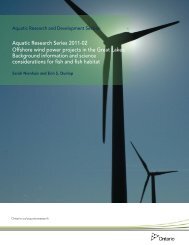Ontario's Natural Heritage Areas - Ministry of Natural Resources
Ontario's Natural Heritage Areas - Ministry of Natural Resources
Ontario's Natural Heritage Areas - Ministry of Natural Resources
Create successful ePaper yourself
Turn your PDF publications into a flip-book with our unique Google optimized e-Paper software.
Image by P.A. Gray<br />
• <strong>Natural</strong> Area Links: <strong>Natural</strong> Area Links are<br />
strategically located corridors that connect<br />
significant natural areas and allow for the free<br />
movement <strong>of</strong> animals and the continuity <strong>of</strong><br />
plant life. They are found primarily between the<br />
Core <strong>Natural</strong> Area and the buffer designations,<br />
but also extend to the edge <strong>of</strong> the greenbelt<br />
connecting it to outside habitats.<br />
• Cultivated Landscapes: Cultivated Landscapes<br />
provide large areas for market-oriented farming<br />
and forestry. They consist <strong>of</strong> large blocks <strong>of</strong> land<br />
with high potential for agriculture and forestry,<br />
typically characterized by productive (Class<br />
1-3) soils, specialty crop land, and land with tile<br />
drainage and buildings in good condition that<br />
can support viable farm or forestry operations.<br />
• Rural Landscapes: Rural Landscapes provide<br />
areas for recreation, landscape protection, and<br />
rural services and businesses. These areas are<br />
comprised <strong>of</strong> lands that conserve the physical<br />
and visual continuity <strong>of</strong> the greenbelt and<br />
provide for public use and enjoyment. Rural<br />
Landscapes <strong>of</strong>fer opportunities for hobby farming<br />
and other related visitor opportunities.<br />
• Buildable Site <strong>Areas</strong>: Buildable Site <strong>Areas</strong><br />
provide space for specialized, large-scale<br />
development. This designation encompasses<br />
strategic locations for facility-intensive uses that,<br />
due to the nature <strong>of</strong> their programs, benefit<br />
from an extensive open area, isolation, or a rural<br />
environment. These areas generally have low<br />
visual quality and little ecological significance,<br />
but are strategically located in terms <strong>of</strong> access to<br />
transportation and servicing.<br />
• Infrastructure Corridors: Infrastructure Corridors<br />
facilitate the movement <strong>of</strong> people, goods, and<br />
services to, through, and from the greenbelt.<br />
These areas channel major services such as roads,<br />
transitways, sewers, and watermains through<br />
the greenbelt in a limited number <strong>of</strong> shared<br />
corridors to avoid unnecessary fragmentation <strong>of</strong><br />
valuable natural or cultivated areas. The multipleuse<br />
corridors <strong>of</strong>ten are the most intensively<br />
developed and used parts <strong>of</strong> the greenbelt.<br />
Most corridors build upon major transportation<br />
links that connect the inner urban area with<br />
the outlying urban communities or other cities<br />
(National Capital Commission, 1996:37-46).<br />
Management Objectives and/or Guidelines<br />
The management objectives <strong>of</strong> the seven land use<br />
designations outlined in the Greenbelt Master Plan<br />
include:<br />
• Core <strong>Natural</strong> <strong>Areas</strong>: The primary uses include<br />
nature interpretation and ecological research.<br />
Acceptable recreational uses include activities<br />
that are enhanced by a natural setting and do not<br />
disrupt natural processes or fragment habitats<br />
(e.g., nature study, walking, and cross-country<br />
skiing on low-impact trails or boardwalks). Core<br />
<strong>Natural</strong> <strong>Areas</strong> are permitted to evolve with<br />
minimal intervention, except in cases where active<br />
rehabilitation protects or enhances ecosystem<br />
health, or where management is required for<br />
reasons <strong>of</strong> public safety.<br />
• <strong>Natural</strong> Area Buffers: Activities conform to<br />
the land’s carrying capacity, level <strong>of</strong> ecosystem<br />
health, and public appreciation <strong>of</strong> adjacent<br />
Core <strong>Natural</strong> <strong>Areas</strong>. Non-intensive or linear<br />
recreational uses such as bicycling, horseback<br />
riding, walking, cross-country skiing, and camping<br />
are encouraged.<br />
• <strong>Natural</strong> Area Links: Uses include a range <strong>of</strong> lowintensity<br />
land uses and activities that preserve<br />
or enhance conditions for the movement <strong>of</strong><br />
wildlife, public appreciation <strong>of</strong> nature, and<br />
improved visitor circulation along the <strong>Natural</strong><br />
Area Link. <strong>Areas</strong> designated as <strong>Natural</strong> Area<br />
Links, but lacking the desired characteristics,<br />
are rehabilitated. Activities that result in the<br />
long-term interruption <strong>of</strong> link functions are<br />
discouraged.<br />
145 Ontario’s <strong>Natural</strong> <strong>Heritage</strong> <strong>Areas</strong>

















